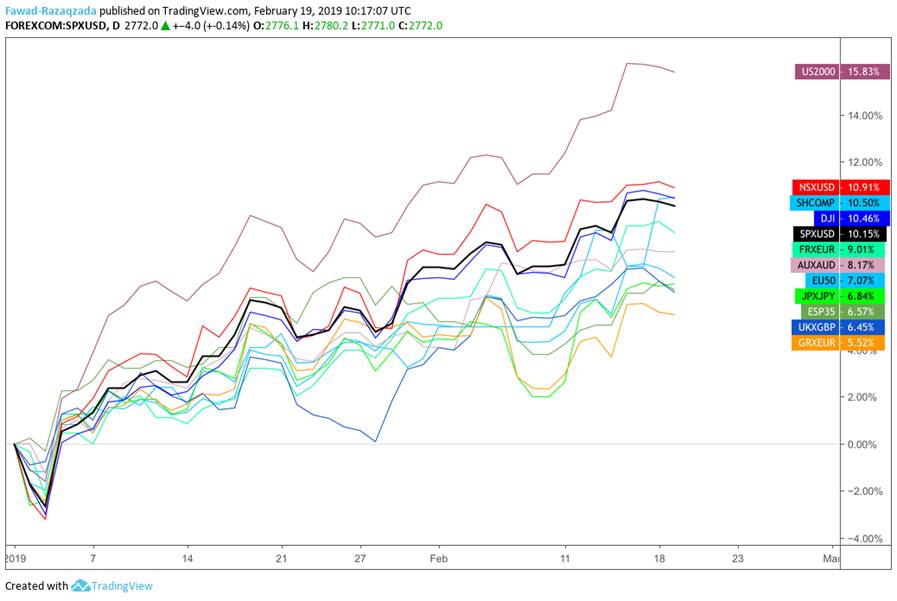US investors will be back from a long weekend break today, knowing they have missed very little yesterday. At the time of writing, US stock index futures were trading just below Friday’s closing levels, tracking weaker European markets. Elsewhere, precious metals have gained further ground, while oil has seen little upside follow-through since Friday. In FX, the USD/JPY has rebounded after slight weakness at the back end of last week; the EUR/USD has once again failed to stay above that 1.13 handle and the GBP/USD has struggled to push north of 1.29 amid ongoing Brexit uncertainty. Commodity dollars have weakened along with European equity prices.
Despite today’s slight pullback in risk assets, the start of 2019 has been very good for equities, commodities and government bond prices. The big rally in global equity markets has been led by the US, while Europe has lagged behind slightly. The upsurge in commodities has been led by crude oil, followed by copper and gold. There are two common denominators behind the markets’ strong performance year-to-date: (1) growing optimism over a trade resolution between the world’s largest economies and (2) speculation that major central banks will keep interest rates low for even longer.
Not only have we recently seen the Fed turning dovish, but there are no signs of imminent rate increases from the likes of the BoJ, BoE and RBA. Indeed, there are now serious doubts that the ECB will tighten its belt in Q3. For that reason, we have seen government bond prices rise and yields fall across the board, which has caused mixed performances in the FX markets with no clear leader among G10 currencies.
Central banks have turned dovish because of concerns over the health of global economy. One major source of uncertainty has been a move towards protectionism, especially in the US. But with the latter potentially on the verge of agreeing a trade deal with China, this has reduced those concerns slightly. Still, the damage might have already been done. Incoming data has been rather poor from some regions of the global economy, not least the Eurozone and in particular Germany. German bund yields have dropped, which has weighed on the euro.
It is possible that US yields could also weaken further as we have seen some warning signs from the world’s largest economy lately, as well. Although there were pockets of strength in some areas of the economy, last week’s data releases from the US were overall disappointing. Among other things, we had a weaker-than-expected inflation report, an unexpected slump in retail sales and a drop in the latest industrial production data.
Further weakness in government bond yields could underpin the lower-yielding and noninterest-bearing assets such as gold and silver even more profoundly going forward, although equities cannot ignore a deteriorating global economy for too much longer. Sooner or later, stock market investors will have to consider the impact on company earnings of a slowing global economy. On top of this, the positivity regarding a potential US-China trade deal will soon be fully priced in.
Figure 1: Global stock indices higher YTD, with US Russell 200 leading the charge while German DAX is underperforming
Source: TradingView and FOREX.com.
Figure 2: Key commodity prices higher YTD, with Brent oil outperforming while silver is lagging behind
Source: TradingView and FOREX.com.
Trading leveraged products such as FX, CFDs and Spread Bets carry a high level of risk which means you could lose your capital and is therefore not suitable for all investors. All of this website’s contents and information provided by Fawad Razaqzada elsewhere, such as on telegram and other social channels, including news, opinions, market analyses, trade ideas, trade signals or other information are solely provided as general market commentary and do not constitute a recommendation or investment advice. Please ensure you fully understand the risks involved by reading our disclaimer, terms and policies.
Recommended Content
Editors’ Picks
EUR/USD edges lower toward 1.0700 post-US PCE

EUR/USD stays under modest bearish pressure but manages to hold above 1.0700 in the American session on Friday. The US Dollar (USD) gathers strength against its rivals after the stronger-than-forecast PCE inflation data, not allowing the pair to gain traction.
GBP/USD retreats to 1.2500 on renewed USD strength

GBP/USD lost its traction and turned negative on the day near 1.2500. Following the stronger-than-expected PCE inflation readings from the US, the USD stays resilient and makes it difficult for the pair to gather recovery momentum.
Gold struggles to hold above $2,350 following US inflation

Gold turned south and declined toward $2,340, erasing a large portion of its daily gains, as the USD benefited from PCE inflation data. The benchmark 10-year US yield, however, stays in negative territory and helps XAU/USD limit its losses.
Bitcoin Weekly Forecast: BTC’s next breakout could propel it to $80,000 Premium

Bitcoin’s recent price consolidation could be nearing its end as technical indicators and on-chain metrics suggest a potential upward breakout. However, this move would not be straightforward and could punish impatient investors.
Week ahead – Hawkish risk as Fed and NFP on tap, Eurozone data eyed too

Fed meets on Wednesday as US inflation stays elevated. Will Friday’s jobs report bring relief or more angst for the markets? Eurozone flash GDP and CPI numbers in focus for the Euro.

